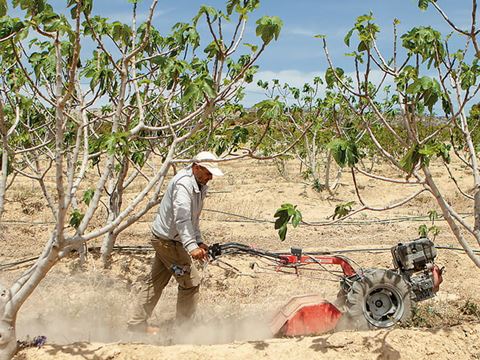
The Secret Science Behind the Beloved Pistachio
Stimulated most recently by nutrition studies and marketing, pistachios are more available worldwide than ever. But today’s efforts are possible only thanks to patient bioengineering some 3,000 years ago.
Satisfyingly dense with a subtle flavor that hints at forests and tree sap, the pistachio never overpowers like, say, cashews might with sweetness or hazelnuts with crunch. This makes them highly versatile: Chefs chop them to encrust filets of fish or meat, toss them in salads and pastas, infuse and scatter them in desserts from baklavas and macaroons to mooncakes and ice cream. Since the late 1990s, pistachios have also been garnering nutritionists and health gurus. It began with studies touting all nuts as good sources of fiber, protein, vitamins, antioxidants and heart-healthy fats, but more recently, pistachios have been singled out for delivering all this at a comparatively lower calorie count.
Global pistachio production has doubled over the past 20 years, according to worldwide statistics compiled by the US Department of Agriculture, which also estimates that this year people will consume more than 760,000 metric tons of this formerly exotic, hard-to-come-by delicacy. Every one of these commercially grown pistachios—whether by farmers in Turkey, Iran, the United States, or on the Italian island of Sicily—are a single species: Pistachia vera, which exists thanks to other farmers who, some 3,000 years ago, engaged in some ingenious bioengineering.
This is the story that is emerging from the work of a team of archeobotanists headed by Robert N. Spengler III, director of the Paleoethnobotany Laboratories of the Max Planck Institute for the Science of Human History and author in 2020 of Fruit from the Sands: The Silk Road Origins of the Foods We Eat.

Unlike walnuts, chestnuts, hazelnuts and pecans, pistachios are technically not tree nuts. They are the seed of a pinkish fruit that grows in bunches. In this respect, they are like almonds, except that the pistachio tree is smaller, shrubbier and biologically more complex. Pistachios are the only dioecious tree nut—which is to say it has male and female trees. Whether wild in a forest or cultivated in an orchard, the optimal male-to-female ratio is one to between 10 and 12. In addition, points out Basira Mir-Makhamad, a doctoral researcher on Spengler’s team and lead author of a 2022 peer-reviewed paper on the domestication and dissemination of Pistacia vera, “It’s very important to keep in mind that Pistacia are wind-pollinated plants.” This is less effective, and less controllable, than pollination by bees. It is riskier as it quite literally depends on which way the wind blows during precisely the handful of days female trees are in bloom. To further complicate matters, male pistachio trees can sometimes be out of sync, blooming up to a full month ahead of the females.

This means there is “a high chance that they will be not pollinated in a proper way,” says Mir-Makhamad. In that case, farmers have to pollinate the trees artificially—something people in Mesopotamia figured out. She points to ninth-century BCE Assyrian bas-reliefs of winged genies shaking a cone over a flowering tree and to historian Strabo’s first-century BCE descriptions of people hand-pollinating dates. “How people got the idea to sometimes take a male flower and shake it over the females to pollinate them,” she exclaims, “it’s genius.”
They would only be called to do this, however, once they had a forest or orchard of Pistacia vera. This would not occur naturally because pistachios do not reproduce true to type. For example, plant a peach, apricot or lemon seed, and you’ll get a plant with the same characteristics as that parent plant. Not so with many other fruits, including most apples, cherries, pears—and pistachios. So the first appearance of the pistachio we know and love today came about randomly. Then humans intervened. A farmer recognized the qualities of this new variant, says Spengler, and figured out that the only way to keep the supply coming was by grafting branches of this tree onto other trees. As he describes it, farmers lopped off the top of a pistachio tree with undesirable fruit, and then lashed a branch from one with tasty nuts onto the severed trunk. The next step was to wait as the tree knitted together the vascular systems of trunk (or rootstock) and branch (scion).
It is impossible to know how and where the idea of grafting arose, says Mir-Makhamad. Perhaps it was through trial and error, or perhaps people were emulating what they saw in nature. “Sometimes it happens that trees are growing so close to each other that they graft,” and the two trees merge into one. The ingenuity here lies in farmers realizing that grafting was a way to have more trees with this same nut, or, as archeobotanists put it, “to lock this variety in place.”

“It’s cloning,” says Spengler. As the grafted scion grows from branch into a full tree canopy, it isn’t just the same species and variety as the favored tree, “it’s the same individual.” Geneticists are showing some clonal varieties last centuries without changing. “It’s a completely different way of thinking about an organism,” he adds. “It’s really amazing that humans figured all this out 3,000 years ago.”
Equally impressive is how scientists today are piecing together what happened. While traditional archeologists search for artifacts to shed light on economic, cultural, religious, and social aspects of human history, archeobotanists like Spengler and Mir-Makhamad illuminate the interactions people have had with plants. While others search for vessels, coins and other man-made artifacts, “I actually look for the carbonized seeds,” he says.
What at first looks like unremarkable bits of debris can be, to her trained eyes, pieces of potential evidence. “When plants are burnt,” Mir-Makhamad explains, they become “just a piece of charcoal,” no longer subject to biological decomposition. Or as she puts it, “fungi and bacteria have no use for them.” So at archeological sites like Paykend and Panjakent, ancient commercial hubs in Uzbekistan and Tajikistan, respectively, she zeroes in on trash pits, fireplaces and ovens. When one turns out to be particularly rich, “I don’t have self-control,” she says. “If we don’t take as much as possible right now, they will just remove everything and just throw it away.” Typically she collects 20 to 30 liters, although she remembers once hauling off a sample of 400 liters.



Left At this site in Penjikent, Tajikistan, archeologists in 2021 and 2022 recovered more than 3,000 seeds from ashy layers, hearths and trash pits. Center Collecting samples, Basira Mir-Makhamad digs in a settlement in Juuku, Kyrgyzstan. She then filters her samples using a flotation system, right, in which seeds rise to the surface, where she can skim them off, and shell fragments, such as the one shown above, sink to the bottom.
At the camp laboratory, she pours the sediment by the cupful into a tank of water, gently swishing it in a process referred to as flotation. Stones and other heavy materials sink to the bottom while carbonized seeds and the like, being very light, “they go right up to the top,” she says, almost in a whisper. “Then, with the hand, we slowly help it to move through [a series of] sieves.” Those with 2-millimeter meshes catch the carbonized seeds, “our black diamonds,” which Mir-Makhamad sets out to dry in a shady spot, carefully arranged on a cotton cloth. She also sifts through the silt at the bottom lest she misses a shell fragment or other treasure.


Back at the Max Planck Institute, Mir-Makhamad studies each of the specimens, identifying and cataloguing their genus and, within that, their species and variety or cultivar. For her paper on pistachios, she also collated the findings on pistachios by fellow scientists and reviewed historical records. Everything, she says, points to farmers having domesticated the pistachio during the first millennium BCE “somewhere within its wild range,” which spanned southern Central Asia, including Tajikistan, Uzbekistan as well as northern Iran and northern Afghanistan. As they cultivated and developed what we now call Pistacia vera into a local cash crop, merchants disseminated it through markets along Silk Road trade routes.
By the first century CE, for example, the Greek physician Dioscorides was proclaiming this nut as a remedy for stomach ailments in his De Materia Medica. By the seventh century, Silk Road pistachios had fans in India and China. And in his 943 CE history of Bukhara, the Sogdian scholar Abu Bakr Muhammad ibn Jafar Narshakhi described bazaars devoted solely to pistachios and tradesmen who specialized in shelling these nuts. But, even then, cultivation was not widespread.
During the first millennium CE, farmers across the Mediterranean and as far away as China chose local and well-adapted pistachio species as rootstocks ... a common practice today on pistachio farms from Turkey to California.
In her study, Mir-Makhamad cites the paucity of seeds found in Pistacia vera’s native habitat as evidence that cultivation of the tree spread gradually and slowly. Farmers in Syria may have led the way by the end of the start of the first millennium CE, but even into the 1500s or so, cultivation remained restricted. Part of this stems from the tree’s complex biology. She cites accounts of pistachios being cultivated in Spain after the Arab conquest of 711 CE, for example. “But it was unsuccessful because of insufficient pollination.”
As with other grafted fruit trees, “when people start to move Pistachia vera, it’s difficult,” says Mir-Makhamad, “because it faces different environmental conditions.” This required farmers first to identify local pistachio species to use as rootstocks, then to know how to graft branches or buds of Pistacia vera onto them, then to have sufficient land to accommodate the appropriate male-to-female ratio and, finally, to have nearly generational patience. It takes between 15 to 20 years before the tree reaches its full maturity, with yields that are high one year, low the next, all in a range from about nine to 20 kilograms of nuts. By comparison an almond tree yields 23 to 30 kilos, and a walnut gives up 30 to 160.
Supply and demand is no doubt one reason pistachios stand today among the most expensive nuts on the market. But their popularity continues to grow: Who can resist a good nut whose shell splits into a smile when ripe? But think of the ingenuity that made a finnicky Central Asian tree nut into a worldwide sensation. For there would be no meeting of demand without farmers who, beginning 3,000 years ago, resorted to graft.
